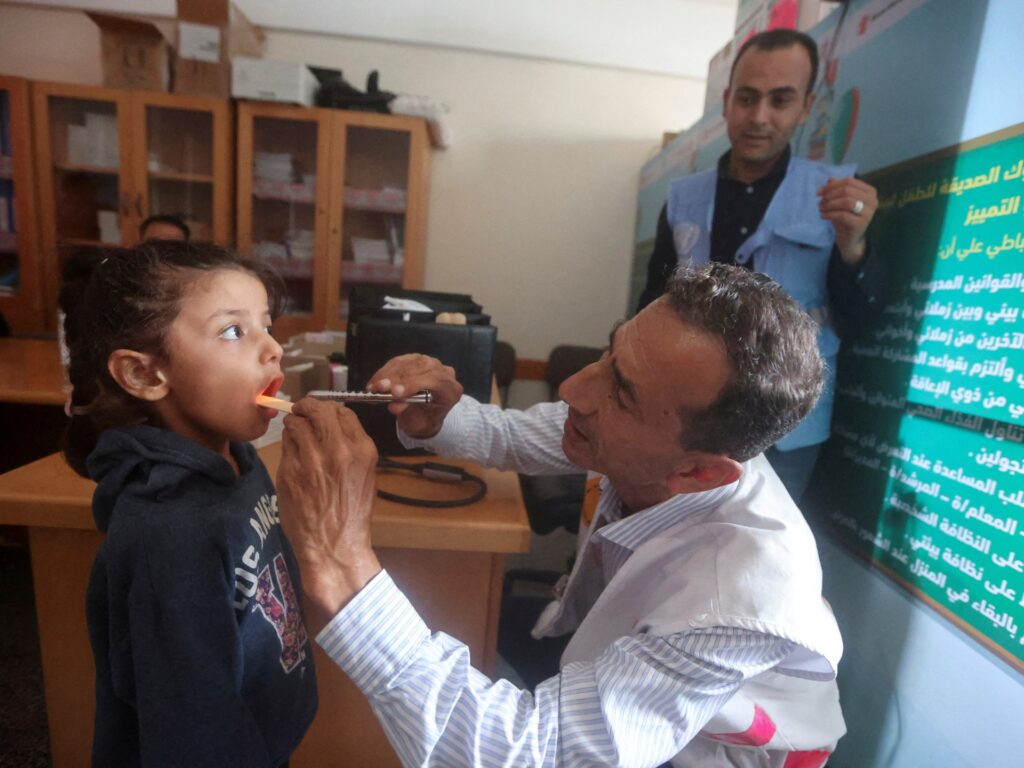As thousands of Palestinians try to find space in Gaza shelters or move south to protect themselves from Israeli bombardments, infectious diseases are spreading in the besieged enclave, according to a report by the World Organization of Health (WHO).
Infectious diseases such as diarrhea and chickenpox are increasing in Gaza, the WHO reported Wednesday, while medical organizations warn of the risk of cholera and epidemics.
Additionally, Gaza’s water and sanitation crises have prevented residents from escaping the impact of Israeli strikes and sieges on their daily lives. The lack of drinking water and the pollutants that proliferate in waterways after infrastructure breakdown have contributed to infections.
Faced with such limitations, hundreds of thousands of people in Gaza are also crowded into shelters, which could accelerate the spread of diseases. Thousands of other people are also marching in crowds from the north to the south of Gaza following Israeli orders to evacuate.
“Between the worrying levels of access to drinking water and sanitation, the extreme density of the population… and a large part of the population which has been evacuated to the three southern governorates, you have a environment highly conducive to an epidemic and the spread of infectious diseases. disease,” said Michael Talhami, strategic program advisor for critical infrastructure and essential services in the Near and Middle East for the International Committee of the Red Cross.
Here’s what you need to know about the main infectious diseases plaguing Gaza since mid-October, according to the WHO.
What diseases affect Gaza the most?
- Upper respiratory tract infections: A total of 54,866 cases have been recorded so far. It mainly affects breathing with symptoms such as a runny nose, cough and sore throat. Respiratory diseases were already the sixth leading cause of death in the Gaza Strip before the war broke out last month.
- Diarrhea: More than 33,551 cases of diarrhea have been reported, at least half of them in children under five, according to the WHO. For comparison, 2021 and 2022 saw an average of 2,000 cases per month in children under five. Drinking contaminated water is one of the main causes of diarrhea.
- Rashes: A total of 12,635 cases have been recorded. Bacteria and viruses can make parts of the skin red, inflamed, and itchy. Rashes and scabies are among the first signs of insufficient water supply for good hygiene, according to Talhami.
- Scabies and lice: A total of 8,944 cases of these parasitic infections have been reported. While lice typically infest the hair, scabies appears on other parts of the body because they prefer to burrow into the skin. Both cause severe itching.
- Varicella: At least 1,005 cases of chickenpox have been reported. This viral illness causes itching, blister-like rashes, and fever. It mainly affects children, but can also infect adults.
Statistics on deaths from infectious diseases are typically reported by the Health Ministry on an annual basis, although WHO is working to get this data more quickly during war, agency officials said .
What are the factors causing these diseases?
Contaminated or inadequate water supplies, overcrowding, and disrupted hygiene are some of the major factors contributing to infectious disease outbreaks.
While some families in Gaza are cramped in apartments, others are finding refuge in UN facilities, some of which have been described by the UN itself as unfit to provide “living conditions”. safe and dignified.
Meanwhile, solid waste is piling up on Gaza’s streets, creating breeding grounds for disease-carrying and transmitting insects and rodents, according to the WHO.
Harmful bacteria have also seeped into Gaza’s water supplies, from the sea to drinking water, becoming a major source of infections whether people are washing their clothes or trying to stay hydrated.
“Even though at the source they treat this water, as it’s delivered, there are many ways that contaminants can enter. And it’s very difficult to monitor in these circumstances,” Talhami said, speaking about of the supply of drinking water.
Additionally, damage to residential buildings can also contaminate domestic water supplies because they are typically connected to infrastructure that runs under main roads and side streets, he explained.
With the sanitation system broken, hundreds of people across Gaza are forced to share a limited number of toilets. In the southern shelters to which people are being evacuated, at least 600 displaced people share the same toilets, according to the United Nations Office for the Coordination of Humanitarian Affairs (OCHA).
In the case of respiratory tract infections, although viruses are a common cause, a 2018 study of war-related injuries in the Gaza Strip also found that inhaling toxic gases from military activities led to respiratory infections. respiratory diseases.
Incomplete coverage of disease surveillance systems, insufficient internet and mobile connectivity, and disrupted medical services have also made it difficult to monitor or respond to infectious diseases.
Even in hospitals, being forced to work with inadequate personal protective equipment or cleaning products means medical staff can also contract and transmit diseases while providing care, WHO said.
Medical sources have reported the presence of whiteflies and their larvae on wounds, which can lead to tissue damage and bacterial infection, according to OCHA.

